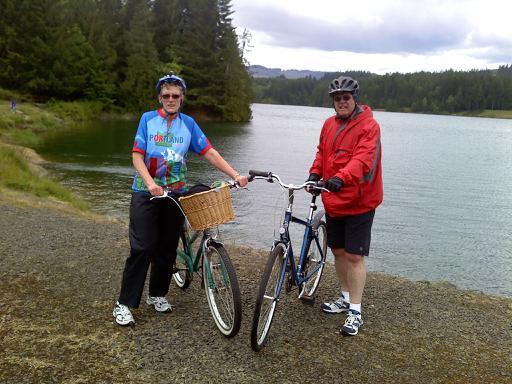No photos today, as we spent the majority of the time in museums, where they don't allow photography.
The earliest museum we visited is called the "Church in the Attic." It dates from the mid-1600's, when the majority of people in the Netherlands had converted from Catholicism to Protestantism due to the reformation, and when Catholic Spain was in an economic and military struggle with Protestant Netherlands. Catholic churches were converted to Protestant and stripped of most of their art (no graven images per the 10 commandments), and it was not possible to profess Catholicism openly. A wealthy Catholic businessman in Amsterdam bought a building to be used for his business on the first floor and his home above that. Then he bought the two houses that adjoined his to the rear and in the upper 3 stories he erected a hidden Catholic church. It's large but hidden from the streets -- a main floor and two balconies.
The second place we visited was formerly a theatre in a district of Amsterdam populated by a large number of Jews. When the Nazis invaded the Netherlands they changed the name of the theatre to Jewish Theatre and allowed only Jews to perform and Jews to attend. As the war progressed they began deporting Jews from the Netherlands, and this theatre was where they were brought to be assembled for transport. The theatre is now a memorial site for the 104,000 Jews who were deported from Amsterdam to work camps and concentration camps. Of those 104,000 only 6,000 survived at the end of the war. As we entered the theatre there was a list of over 60,000 last names of the people deported. Since many people could share the same last name, this 60,000 names was only a fraction of the number of actual people deported. It takes a lot of room to list 60,000 names andd I can't even imagine that many people being rounded up solely because of their religion. The remainder of the memorial had photos of the people deported (from family photo albums, so scenes not at the time of deportation). They also had examples of passports stamped with a J for Jew, yellow stars that people had to sew on their clothing, and mementos from the Jewish theatre, as well as individual stories of the people deported.
The third place we visited was the Resistance Museum, which told the story of the Dutch resistance from 1941 through the end of the war by displaying photos, audio recordings and personal testimonies of people who were in the resistance throughout the Nazi occupation. The thought that I had at this museum was that there was a point of decision for each person at which point and for which reasons they chose to cooperate or not with the occupying forces. For instance, was it better to decide to cooperate at the beginning with the Nazis in the hope of being able to influence them and make things easier for your employees, or was it better to resist from the start, be arrested and have a Nazi in charge of your department. Or, later on, when confronted with the choice of cooperating with an obviously wrong tactic because if you didn't the Nazis would shoot 24 of your comrades? Tough decisions. Or if you had small children in your home and a Jewish neighbor sought a hiding place with you for his family or maybe even one of his children whom you could pass off as one of your own, would it be right to place your family, including your children, in jeopardy to hide your neighbor. Again, tough decisions. I think it's not possible to make those ahead of time, but that each decision would require a lot of prayer and contemplation.
'Nuff said. We are off for our final dinner in the Netherlands.
Thursday, July 1, 2010
Subscribe to:
Comments (Atom)
